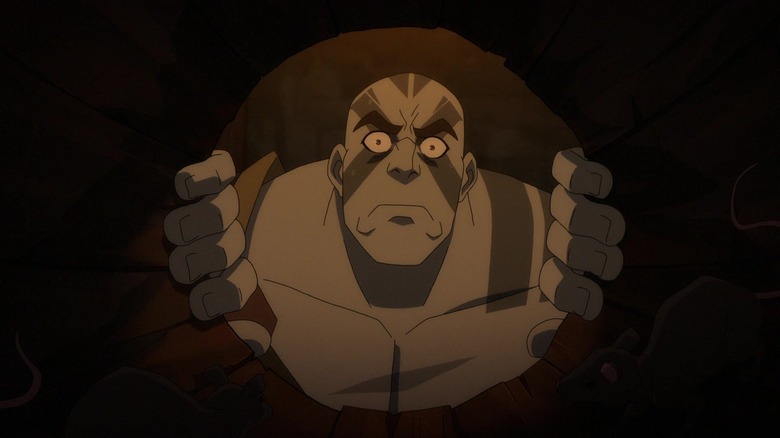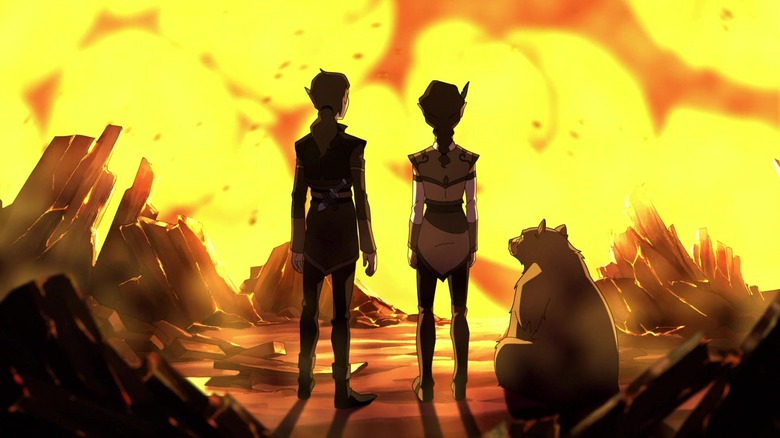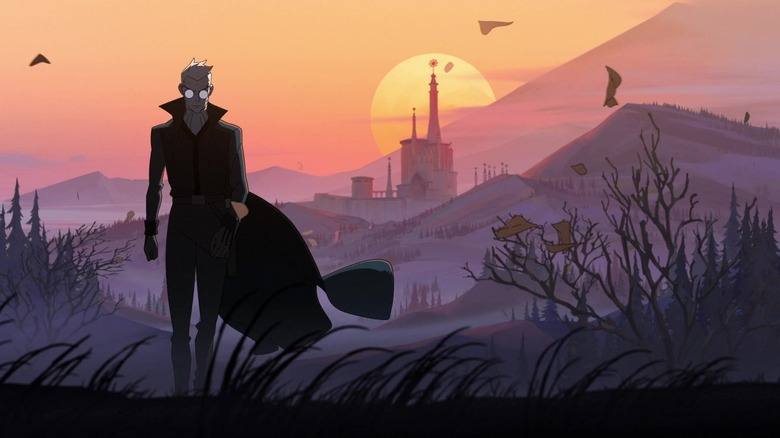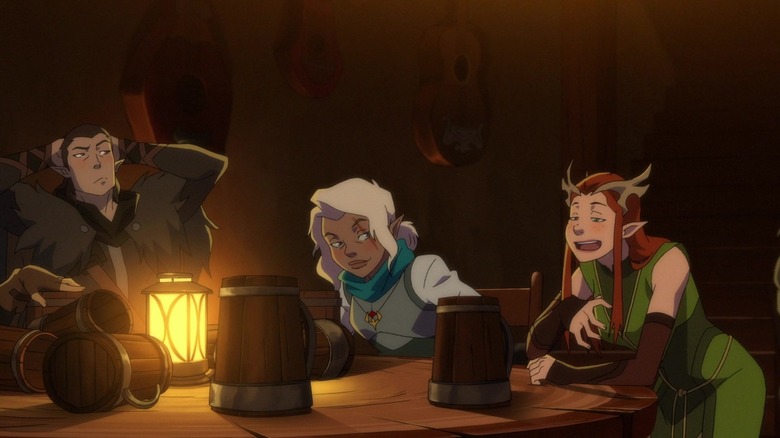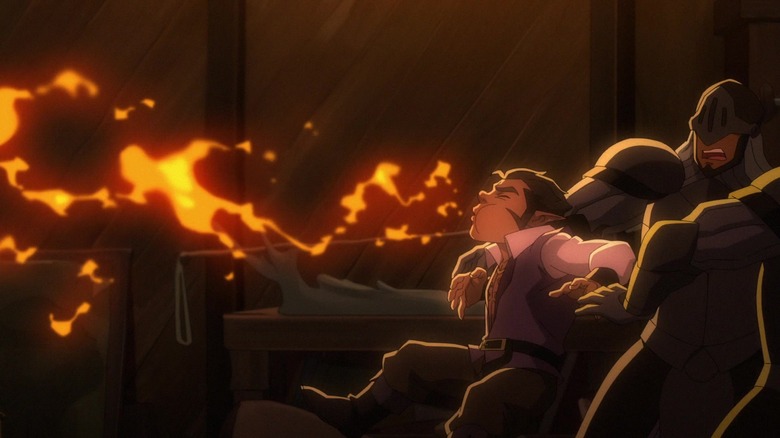Condensing Critical Role For The Legend Of Vox Machina Was As Hard As It Sounds
On the surface, "The Legend of Vox Machina" is the perfect fit for an animated series. Take the first season of the hugely successful actual play podcast "Critical Role," translate its fantastical story to the screen, bring in the show's crew of voice actors to play their characters, and pick the talented Studio Grackle (best known for contributing animation to the popular video game "Hades") to handle the opening credits. It's a slam dunk. Then you crunch the numbers. The first "Critical Role" campaign, on which "Vox Machina" is based, is 115 episodes and totals "about 400 hours," per player Travis Willingham in an interview with Inverse. By contrast, each season of "The Legend of Vox Machina" is 12 episodes long. An episode runs roughly 24 minutes.The recent release of the second season brings the runtime of the "Vox Machina" animated series to under 12 hours, less than three percent the total length of the first campaign. In fact, the animated series as it exists today is only as long as two to three full episodes of "Critical Role" added together.
Animated series have run for over 400 hours before. The popular anime "One Piece" is still going strong after 1049 episodes, and other series (like the immortal "Sazae-san") have aired for even longer. But "One Piece" is based on one of the best-selling comics in history. "Vox Machina" started as a Kickstarter project. They aren't playing in the same league. Even after being picked up for two seasons by Amazon Prime, a full-length retelling of "Critical Role" was likely impossible, especially at the level of quality fans would expect. Only one option remained for the cast and crew of "The Legend of Vox Machina." They had to trim it down.
At the whiteboard
It's enough to crush the heart of any die-hard fan. But to the players of "Critical Role," it was just business. "It came down to all of us sitting in a room with all the major story beats on whiteboard and in long documents..." Dungeon Master Matt Mercer told Inverse. From there, it was simply a matter of "condensing it the best we can within the limits we have." Mercer and his cohort were no longer playing "Dungeons & Dragons." They were taking a bird's eye view of their campaign, something that is impossible at the table no matter how carefully you plan. Instead of dice, they had a team of TV writers drawn (per Inverse) from shows like "Westworld" and "Once Upon a Time." Their goal was to refine the raw essence of that first "Critical Role" campaign into an accessible fantasy narrative that retained the flavor of the source material. According to an interview with Eric Kain, it was important to Mercer that "everything is genuine and honest to what we originally created."
Other members of the team believed that including outside talent could only improve "Vox Machina." In the interview above, Travis Willingham speaks highly of the show's writer's room, saying that "they're coming to it with fresh eyes and a fresh perspective." Actual play series inevitably lead to Stockholm syndrome among their fans, who invest so much time and attention that they're willing to put up with just about anything to spend more time with their favorite people. But the players of "Critical Role" understood that cutting and rearranging their magnum opus was necessary, even if that meant rewriting storylines or removing fan-favorite scenes.
Challenges and opportunities
The first "Critical Role" campaign has a particularly fraught relationship with "canonicity" and "faithfulness." Player Marisha Ray (voice of Keyleth the druid) said to Polygon that they "had been playing as a group for two and a half years before we decided to take it to the stream..." The first episode starts in medias res; rather than a true "pilot episode," it comes off as just another installment of a typically indulgent "Dungeons & Dragons" session. As the series continued, a player left the group, the production quality increased and the cast became more comfortable performing on screen. Even then, says Ray, "there were a lot of character building and backstory moments" from earlier in the campaign "that the audience never saw," because they were not recorded or archived. Some of these elements are preserved in "Vox Machina," providing context that many fans of "Critical Role" never had to begin with.
"Critical Role" isn't the first actual play series to endure adaptation. "The Adventure Zone," another very popular podcast where the McElroy family play "Dungeons & Dragons," has become a successful series of graphic novels courtesy of artist Carey Pietsch. Like Willingham and Ray, the McElroys are realistic about squishing each section of "The Balance Arc" into 200 page comics. Said Travis McElroy to Comics Beat in an interview, "the challenges" of translating one medium to another "also come hand-in-hand with opportunities." Funny voices are out, but body language and facial expressions on the page can be just as effective. Travis also spoke to the team's ambitions to "smooth out the original arc." Among other things, this meant fleshing out the first storyline, "Here There Be Gerblins," which was conceived before the McElroys knew just how big "The Adventure Zone" would become.
The beating heart of fantasy
It's Pietsch, though, who gets at the root of the show's appeal. Something she enjoyed about the early storylines, she says, is that "you could really hear the players... getting comfortable with their characters, each other, the format..." Rather than rapidly evolving the cast into their most confident selves, she was careful to depict this evolving dynamic while adapting the story with the McElroys. Another common refrain when it comes to actual play is that a show "gets better" after a certain number of episodes, or that starting several episodes in is recommended. But Pietsch understood that "the teamwork that it took... to get to that place where [the cast] are all comfortable with each other" is the actual play secret ingredient. Rather than accuracy of content, pacing is what makes or breaks the story.
Time is a powerful storytelling tool. Magical girl shows like "Sailor Moon" utilize repetition and year-long runtimes to depict the cast's slow maturation from girls into young women. Fantasy series like "The Wheel of Time" engender deep attachment in their readers, even when the text itself is so threadbare it barely holds up to scrutiny without reader buy-in. Similarly, actual play captures over many hours the process by which ordinary people become increasingly confident in their shared roles. Series like "Critical Role" could be said to represent the final evolution of the fantasy genre, following in the footsteps of novels like "Dragonlance" and "Record of Lodoss War" derived from tabletop campaigns. After all, says Dia Lacina in her review of the video game "Deedlit in Wonder Labyrinth," "the adaptation of an adaptation of a transcript built of poorly veiled stolen IP is the beating heart of ALL fantasy."
Actual play
"The Legend of Vox Machina" is both less and more than that. Rather than a 400 hour experimental television series streamed over the internet, it's so far just 24 episodes of an animated series based on somebody else's tabletop campaign. But then, what's more indulgent than paying somebody to transform your table campaign into a twenty-four episode animated series streaming on Amazon Prime? Not much. "Vox Machina" isn't so much a condensed version of "Critical Role" as it is the scat of a dragon grown out of control. (Dragons, according to the animators at Titmouse, are quite difficult to animate.) A dragon that has also spawned comics, tie-in merchandise and countless other actual play shows and podcasts riding its coattails.
Animated series aren't better or worse than actual plays, just different. The uncertainty of dice rolls, player improvisation and the energy in the room at the time cannot be fully translated into a television show. "The Legend of Vox Machina" and "Critical Role" only stand to benefit by diverging from each other. An episode of "Vox Machina" is over and done in just thirty minutes. The series reinterprets the freeform fun of the greater series as conventional narrative, offering images and grand-scale action scenes that would be prohibitively challenging to realize in live action. Some may be satisfied with that. For those willing to dive even deeper, the 400-plus hours of "Critical Role" offer a satisfying world to explore. So long as "Vox Machina" and "Critical Role" continue on their separate tracks, I'll be happy to have both. Although I have to ask, when are we getting a "Friends at the Table" animated series? It's long overdue.
